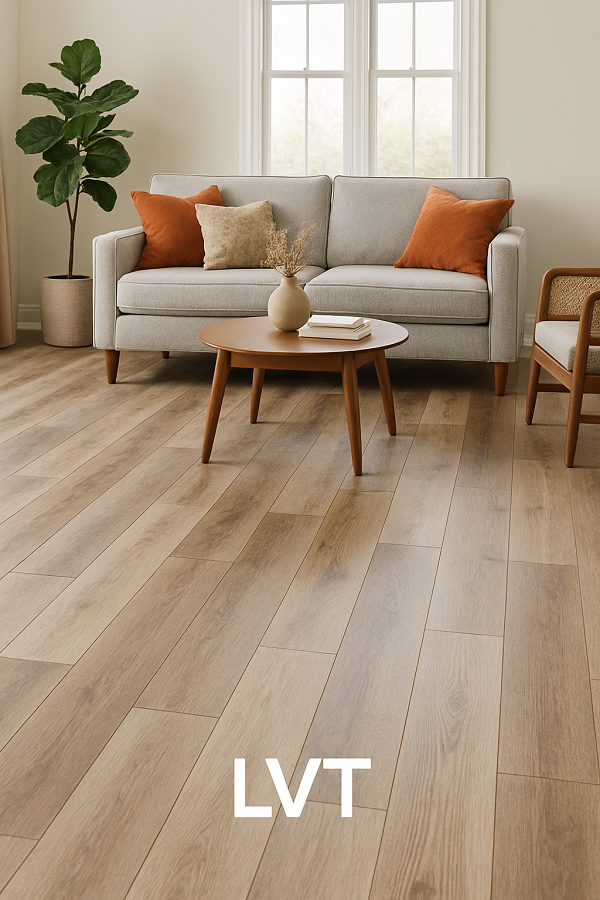Luxury Vinyl Tile (LVT) is a multi-layered flooring product that accurately mimics natural materials like wood, stone, and ceramic at a lower cost.
Its key functions are:
- Durability & resilience: Built with a waterproof core and tough wear layer, it resists scratches, dents, and stains.
- Visual appeal: High-resolution printed surfaces recreate wood grain and stone textures convincingly.
- Comfort & functionality: Softer underfoot and quieter than stone or wood; compatible with underfloor heating.
Ideal for busy environments like kitchens, bathrooms, basements, offices, and rental spaces, LVT Flooring balances beauty with robustness.
Pros of LVT Flooring
Waterproof & moisture-resistant
- Ideal for wet areas like kitchens, bathrooms, basements, and boot rooms.
- SPC-core options offer full waterproof performance.
Highly durable
- Resistant to everyday wear—foot traffic, pets, and spills leave minimal trace.
- Quality layers repel dents and scratches better than traditional vinyl.
Low maintenance
- Simply sweep and occasionally mop; no polishing or sealing needed.
Style variety
- Extensive palettes: wood plank, natural stone, geometric patterns, herringbone, chevron—suited for any interior style.
Budget-friendly
- Costs substantially less than hardwood or stone (approx. $2–8 / sq ft vs. $12–20 / sq ft for hardwood).
Easy installation
- DIY-friendly click systems allow floating installs over most subfloors; glue-down models available too.
Comfort & insulation
- Softer underfoot and quieter; built-in underlayment improves thermal comfort.
Pet- and family-friendly
- Ideal for households with kids or pets—easy to clean and resistant to damage.
Cons of LVT Flooring
Not refurbishable
- Unlike wood or tile, LVT can’t be sanded or refinished—damaged tiles must be replaced.
Repair/replacement challenges
- Wear layer damage often requires replacing full tiles or planks. Pattern discontinuity may complicate matching.
Shorter lifespan than natural materials
- Typically lasts 10–20 years, compared to 25–50+ years for hardwood or tile.
Color fading risk
- UV exposure can discolor thinner wear layers over time.
Can feel less “real”
- Some lower-end products can appear synthetic and lifeless.
Environmental concerns
- Made from PVC; not biodegradable, limited recycling.
- Certain types may emit VOCS.
Temperature sensitivity
- Extreme heat or cold may cause expansion/contraction, requiring acclimation and proper gaps.
Price vs laminate
- Though cost-effective versus tile/wood, LVT can be pricier than laminate while offering similar visual benefits.
Recycle/removal difficulty
- Tough to recycle PVC; glued-down versions are labor-intensive to remove.
Product Features & Instructions
Layer composition:
- Wear/topcoat, design film, rigid PVC/SPC core, backing layer.
Core options:
- Rigid SPC cores offer superior waterproofing; WPC cores provide better comfort.
Wear layer thickness:
- 0.2–0.7 mm; 0.5 mm+ recommended for high-traffic or commercial use.
Installation steps
- Prep: Ensure subfloor is clean, dry, level. Use vapor barrier if on concrete.
- Acclimate: Let planks/tiles rest in room climate.
- Lay: Start along a straight line, maintain 1/4″ expansion gap. For click-LVT, float; for glued, adhere firmly.
- Finish: Trim edges, install baseboards to cover expansion.
- Care: Sweep regularly; use damp mop—avoid steam cleaners .
Applicable Industries & Settings
- Residential: Kitchens, baths, basements, living areas, boot rooms and childcare spaces.
- Commercial: Retail, offices, rental properties, hospitality—durable and low-maintenance.
- Specialty: Healthcare, educational, or fitness facilities needing cleanable, water-resistant, comfortable floors.
Target Customer Groups
- Families & pet owners: Ideal for wear resistance, spill resilience, and easy clean-up .
- DIY enthusiasts: Click systems suit self-install projects .
- Budget-conscious buyers: Seeks upscale style without hardwood/tile costs .
- Commercial buyers: Require long-lasting, low-maintenance, versatile flooring .
Summary Comparison Table
| Aspect | Pros | Cons |
| Durability | Scratch-, stain-, water-resistant | Cannot be refinished; damage requires replacement |
| Appearance | Wide design options, near-natural aesthetics | Low-end products may look artificial; fading possible |
| Installation & Cost | DIY-friendly, fast installation, affordable | Removal can be laborious; more expensive than laminate |
| Comfort & Sound | Softer and quieter than tile | Feels less solid compared to hardwood or tile |
| Environmental Impact | Low maintenance—with no harsh chemicals | PVC-based, limited recycling, occasional VOCS |
| Lifespan | Good value for moderate lifespan | Shorter than hardwood or tile investments |
LVT flooring delivers a compelling blend of style, durability, comfort, and affordability, particularly suited for active homes, commercial spaces, and DIY installations. Its impermeable nature makes it a favorite in wet and high-use zones. The main compromises—no refinishing, eventual wear, and environmental impact—can be offset by choosing high-quality products (SPC core, thick wear layer) and ensuring diligent installation and maintenance.


































